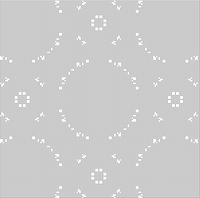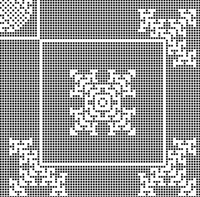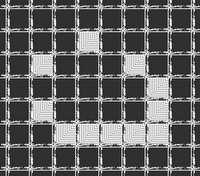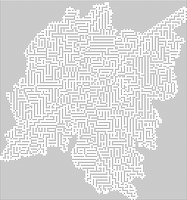This is a speculative project that has been in the works for a long time: an odd-period Herschel loop that includes a switch-engine stage. I wanted to see what
David Bell's "swimmers" looked like when incorporated into a stable Herschel track. The current version isn't exactly pretty, but it does work. Here's the
RLE pattern file.

What Went Wrong This Time?
The center of this circuit is an extensible Herschel fanout device based on paired F171 conduits. Theoretically adding another synchronized signal is simply a matter of adding another pair of F171s to the beginning of the series, and running a Hersrch search to produce an appropriately-timed output. F171 is a relatively slow conduit, so you do get a little extra time for adjustments with each new pair.
But it turned out not to be enough; it gets increasingly hard to reach around the edges of the conduits that have already been placed. After using the last four outputs (circuits 6, 5, 4, and 3, working backwards -- the two ends of the F171 chains, and the two extensible tandem-glider outputs) it was impossible to route the previous tandem-glider signal around to get it where I wanted it fast enough. The signal could be hurried into the general neighborhood, but it didn't quite hit any of the spacetime locations I needed. I tried most if not all of the likely Herschel-to-glider converters that could produce either of the two gliders coming in from the southwest.

I should probably have tried simply skipping the output of one F171-pair and checking to see if 342 ticks was enough extra time to allow a connection from one link further back. Something to try next time around --
In this case, the failure of the extensible fanout meant that other types of Herschel fanout devices (circuits 1 and 2 in the labeled MCell "envelope" diagram at right) had to be bolted on instead, before the split that feeds the two F171 chains. This allowed plenty of time to route two signals around to feed the SW shotgun, though the design uses up a lot more space and the conversion takes longer.
As usual, the layout was done from the inside out, so to speak, with the H-to-G converters in the deepest part of the fanout tree "solved" first. Also as usual, toward the outer edges expert Herschel plumbers may detect hints of increasing impatience with high-level architectural issues...
Not Good Enough Yet
Unfortunately I'm going to have to rebuild the whole thing eventually, because of a mistake I made in the layout very early on. Basically I thought I had a clean way to get a Herschel to the northeasternmost H-to-G converter (circuit #6) in the right number of ticks, but there was a flaw in the only conduit that fit there: it worked only half the time (i.e., it needed a blinker as one of its suppressing catalysts, to keep the Herschel signal from interfering with other catalysts later on; otherwise it produced an extra blinker).
So to make this odd-period loop work, there's a huge extra Herschel conduit bolted on to the top of the converter (circuit 6b) to suppress the extra blinker. 6b is a large slow glider-to-Herschel converter -- this was the easiest way to get a spare Herschel out without changing the rest of the circuits.
The repeat rate of the full circuit was going to be up in the 600-tick range in any case, because of the boojum-transmitter adjustment I used in circuit #2... and because the swimmer-to-Herschel stage at the other end of the channel uses basically the same slow glider-to-Herschel mechanism, except it reflects an extra glider back to clean up a junk block.
In any case, two Herschels are doing the job of delivering the last glider to the northeast in the switch-engine recipe, where one Herschel should really be plenty... kind of spoils the whole construction. I'm not sure the idea of "elegance" really applies to these extended Herschel-track experiments -- but anyway it isn't quite up to my arbitrary standards for these things.
General notes on multi-Herschel constructions
Laying out these things is a balancing act between ridiculously large solutions and ridiculous amounts of time spent working out the bugs in more compact circuitry. It's easy to produce any glider timings you want, for example, if you leave enough space for a boojum-reflector timing adjustment on every signal path; known Herschel conduits can give you output gliders with any timing mod 8, relatively quickly (usually three or four conduits, sometimes two -- assuming the output lane is an reasonable distance ahead of the input Herschel.)
But when adjustments are necessary, it tends to affect the compression of the circuitry: if the adjusted boojum-reflected glider is sent into a tandem-glider transceiver, the repeat time will get worse the more the reflector is moved back. If the glider goes into a standard G-to-H, then you're immediately stuck with the repeat time of the G-to-H (currently I think this is still at least 497 ticks). Thus a "good" circuit design should probably try to avoid adjustable components -- ideally the signal-splitter outputs should be routed fairly directly toward their goals. Too bad it never actually seems to work that way...
Another Approach (that doesn't seem to work)

I'd also like to have one more look at the idea of using junk still-lifes or oscillators to keep the switch engine going in its early cycles, on the way from the construction site into the diagonal track. Currently two of the six gliders in the recipe just suppress the switch engine's exhaust, doing the same job that the boats do in the permanent track. A simple block, blinker, or beehive can do the same job, and get cleanly destroyed in the process; they can be placed any time after the initial construction gliders go by but before the switch engine hits the key spot with its exhaust.
#C Four gliders plus two blocks produce a 'swimmer'
#C -- the blocks must be placed after the gliders go past.
#C Theoretically Herschel-to-block converters might make this
#C as efficient as the six-glider version, but Herschel tracks
#C close to the swimmer lane tend to get in the way of
#C the incoming gliders; an all-glider solution was much easier.
x = 69, y = 71, rule = B3/S23
19bo$17b3o$16bo5boo$16boo4boo3$25bobo$25boo$26bo$$15bobo$16boo$16bo$oo
$oo3$29bo5boo$28bo6boo$28b3o$5boo$5boo$$20boo21boo$19bobo20bobo$21bo
21bo4$15boo$15boo$51boo$50bobo$51bo3$22bo$21bobo$21boo$59boo$58bobo$
59bo3$30bo$29bobo$29boo$67boo$66bobo$67bo3$38bo$37bobo$37boo6$46bo$45b
obo$45boo$$67boo$67boo3$54bo$53bobo$53boo!
I spent a lot of time fiddling around with Herschel-to-junk converters a few months back, but discovered as usual that being able to adjust the timing of the suppressing signal -- i.e., building the suppressing junk at any of a moderate range of times during the construction -- wasn't worth losing the wider range of adjustability in the delivery location: when you're placing stationary junk you have to hit the right location exactly and you have to worry about the converter catalysts getting in the way, where with a glider you can place the H-to-G converter anywhere along the input diagonal.
Five Types of Interchangeable Signals
It seems a little odd that there aren't more kinds of asynchronous signal tracks by now. For tracks where converters to and from other signal types have been explictly constructed, we've got gliders, *WSSes, Herschels, 2c/3 diagonal wires, and now switch engines. How many have I left out? Even if we say that the tracks can contain low-period oscillators, I don't think there are very many more types (?)
I'd say that things like Caterpillar blinker trails and telegraph wires don't count (yet) because they move each time they're used, and nobody has bothered to set up a way to send a signal through only when an input comes in. Theoretically a telegraph could transmit information asynchronously, but not if it's being powered by high-period guns as in the current model (a signal is sent every cycle, but it's modified slightly depending on the input.)
I do have a rough design for an asynchronous telegraph that avoids sending ten pulses per signal (or a reverse signal) to reset the wire. But it would end up similar in size and latency to the current model, and at this rate it will be several years to never before that sees the light of day. Converters using Corderships or 2c/5 spaceships as signals would be at a similar order of size and level of effort.
Maybe someone can supply p15 converters to get a signal out of an orthogonal pi-heptomino track made of pentadecathlons --

#C pi-heptomino conduits: Dean Hickerson, 17 February 1997
#C Herschel-to-pi stage by Paul Callahan (part of Fx176)
x = 151, y = 75, rule = B3/S23
124bo3bo$123boo3boo6$104boo6boo25boo6boo$103bobbo4bobbo23bobbo4bobbo$
102b6obb6o21b6obb6o$103bobbo4bobbo23bobbo4bobbo$104boo6boo25boo6boo6$
107b4o$106b6o$105b8o$104boo6boo$105b8o$35bo17bo17bo17bo16b6o$34bobo15b
obo15bobo15bobo16b4o$135b3o$134bo3bo$34b3o15b3o15b3o15b3o43bo3bo$34b3o
15b3o15b3o15b3o44b3o$35bo17bo17bo17bo$95boo$95boo$35bo17bo17bo17bo$34b
3o15b3o15b3o15b3o44b3o$34b3o15b3o15b3o15b3o43bo3bo$134bo3bo$135b3o$34b
obo15bobo15bobo15bobo$11boo8boo12bo17bo17bo17bo$12bo8boo$12bobo$13boo
$$126boo$7boo117boo$8bo$8bobo$9boo$$116bobboboobobbo$116b4oboob4o$116b
obboboobobbo3$9bo$9bobo$9b3o$11bo$$21boo$21boobboo8bo17bo17bo17bo$25bo
bo6bobo15bobo15bobo15bobo17boo$bboo23bo80boo$3bo23boo$3o31b3o15b3o15b
3o15b3o$o33b3o15b3o15b3o15b3o$35bo17bo17bo17bo3$35bo17bo17bo17bo$34b3o
15b3o15b3o15b3o$34b3o15b3o15b3o15b3o3$34bobo15bobo15bobo15bobo$35bo17b
o17bo17bo!
Getting the signal started is no problem, using a stable Herschel-to-pi stage, but I don't think anyone has found a good converter for the end yet. Should be possible to engineer a multi-stage one, at least, where some useful junk is destroyed and re-created. Obviously it would be p15 or p30, not stable, but it would still be fun to see a really big pi orbital working.
A Small Direct Converter (if wishes were horses)
When Brice Due was working on a revision of ptbsearch last year, I held out some hopes that a compact H-to-S (Herschel-to-swimmer) converter might happen show up, once the search code started keeping an eye out for "tamable" switch engines along with other more likely transients (Herschels, B-heptominos, R-pentominoes, and so forth.)
Come to think of it, one could also keep an eye out for transient patterns that could trigger a 2c/3 signal -- a direct H-to-2c/3 would save even more spaghetti wiring than an H-to-S would... though a direct 2c/3-to-H is probably a harder problem, maybe more something for a 'dr'-type search on a new supercomputer, or a distributed computing system.
Distributed Searches?
Periodically I try to work on finding a way to usefully distribute an exhaustive ptbsearch search (or dr or wls -- pick your poison). But so far I've more or less hit a wall and bounced off, every time. The most promising line of research seems to be finding a way to short-circuit repeated searches in one area, probably using hash tables and lots of RAM.
To make this a little less vague: you often notice that a search problem splits into separate sub-searches, where you end up going through all the permutations of Solution A | B | C ..., say in one corner of the search area, and Solution Z | Y | X ... in another corner. Since the local conditions are identical and [A|B|C...][Z|Y|X...] works equally well in any combination, it might really only be necessary to go through A, B, C... once and Z, Y, X... once, and record the results of the search in a hash table somehow.
Might work even better to short-circuit searches that _don't_ produce solutions; how much of a WLS search involves going over the same ground over and over, for example? My perception is that a majority of WLS's time is wasted chasing its tail in this way -- but quite possibly that's just an artifact of my relative inability to set up successful WLS searches!
Anyway, maybe one of these days we'll get there. A non-engineered "Conway-space" H-to-S would go a long way toward allowing Herschel circuitry to be packed into tighter spaces: at the moment, the new F171 is the best diagonal conduit available. Oherwise, parallel circuits that run diagonally tend to have to travel Manhattan-style, with a lot of 90-degree turns and sharp corners that get in each others' way -- or they have to convert signals to tandem gliders and back, which is also fairly awkward (mostly because of chirality limitations in the standard transmitter).
































